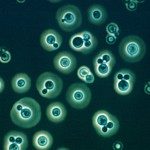Link to Pubmed [PMID] – 16696662
FEMS Yeast Res. 2006 Jun;6(4):652-61
Cryptococcus neoformans is the causative agent of cryptococcal meningoencephalitis. There is accumulating evidence that C. neoformans is a facultative intracellular pathogen, residing in macrophages and endothelium. The molecular mechanism conferring resistance to phagolysosomal killing in these cells is a key unresolved issue. To gain insight into the fungal adaptive strategies, serial analysis of gene expression was used to map genes differentially expressed in an intraphagocytic environment. By comparing transcript profiles of C. neoformans serotype D B3501 cells recovered from endothelial cells with those from free-grown cryptococci, we identified the cryptococcal homologue of the SKN7 two-component stress response regulator gene from Saccharomyces cerevisiae. Studies with C. neoformans cells disrupted for SKN7 revealed an increased susceptibility to t-butyl hydroperoxide (100% lethality at 0.7 mM, vs. 1.0 mM for wild type) and significantly lower survival rates in endothelial infection experiments. Mice experiments revealed that SKN7 disruption strongly attenuates cryptococcal virulence in vivo. We propose that Skn7 (co-)regulates the fungal adaptive strategy, allowing intraphagocytic survival by conferring resistance to phagolysosomal killing in endothelial cells.


